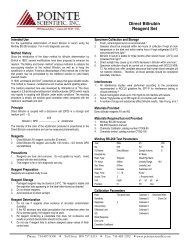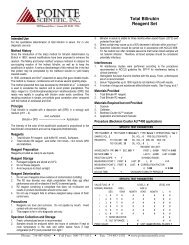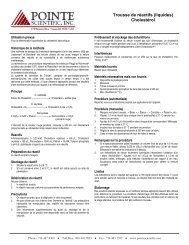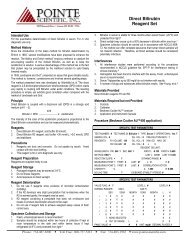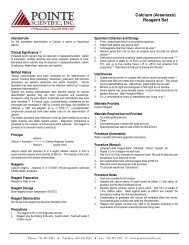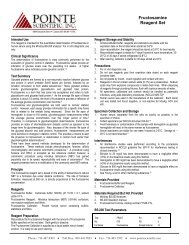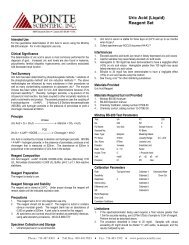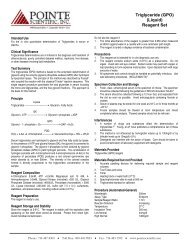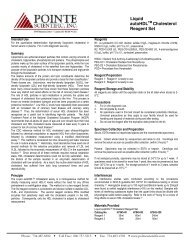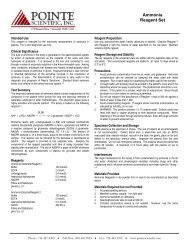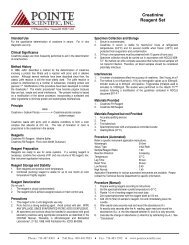12-A7516-100 - Pointe Scientific, Inc.
12-A7516-100 - Pointe Scientific, Inc.
12-A7516-100 - Pointe Scientific, Inc.
Create successful ePaper yourself
Turn your PDF publications into a flip-book with our unique Google optimized e-Paper software.
Alkaline Phosphatase<br />
(Liquid)<br />
Reagent Set<br />
Intended Use<br />
For the quantitative determination of alkaline phosphatase in human serum<br />
using the Mindray BS-200 analyzer. For in vitro diagnostic use only.<br />
Clinical Significance<br />
Serum alkaline phosphatase estimations are of interest in the diagnosis of<br />
two groups of conditions; hepatobiliary disease and bone disease associated<br />
with increased osteoblastic activity. 1<br />
Test Summary<br />
Alkaline phosphatase in serum is determined by measuring the rate of<br />
hydrolysis of various phosphate esters under specified conditions. ρ-<br />
Nitrophenyl Phosphate is one such phosphate ester and was introduced as a<br />
substrate by Fujita in 1939. 2<br />
Bessey, Lowry, and Brock published an endpoint procedure in 1946 3 while<br />
Bowers and McComb reported a kinetic procedure in 1966. 4 The kinetic<br />
procedure has undergone several modifications and been recommended for<br />
routine analysis. 5,6 This liquid reagent is based on the recommended<br />
method of the AACC. 7<br />
Principle<br />
Alk. Phos.<br />
ρ-NPP + H2O -----------------------‣ ρ -Nitrophenol + H3PO4<br />
ρ-Nitrophenyl phosphate is hydrolyzed to ρ-nitrophenol and inorganic<br />
phosphate. The rate at which the p-NPP is hydrolyzed, measured at 405<br />
nm, is directly proportional to the alkaline phosphatase activity.<br />
Reagent Composition<br />
After combining R1 and R2 as directed the reagent contains: AMP Buffer<br />
(pH 10.45), ρ-NPP ≥16mM, Magnesium ions ≥1.0mM, activators and<br />
preservatives.<br />
Reagent Preparation<br />
The reagents are ready to use.<br />
Reagent Storage and Stability<br />
Store reagent set at 2-8°C. The reagents are stable until the expiration date<br />
if stored as directed. Protect from direct light and avoid microbial<br />
contamination. NOTE: The R2 reagent is temperature sensitive and can be<br />
affected by prolonged exposure to room temperature. Return reagent to 2-<br />
8°C as soon as possible after use.<br />
Precautions<br />
1. This reagent set is for in vitro diagnostic use only.<br />
2. Do not ingest any material, toxicity not determined.<br />
3. Do not use if the initial absorbance of the working reagent is greater<br />
than 1.0 at 405 nm or if the reagent fails to meet the stated parameters<br />
of performance.<br />
4. Reagent should not be used if it fails to recover stated values in control<br />
sera or shows evidence of microbial contamination.<br />
5. All specimens and controls should be handled in accordance with good<br />
laboratory practices using appropriate precautions as described in the<br />
CDC/NIH Manual, “Biosafety in Microbiological and Biomedical<br />
Laboratories,” 2 nd Ed., 1988, HHS Publication No. (CDC) 88-8395.<br />
Specimen Collection and Storage<br />
1. Use non-hemolyzed serum (plasma should not be used since anticoagulant<br />
agents inhibit alkaline phosphatase activity). 8,9<br />
2. Serum samples should be stored at 2-8°C and run within two days. 10<br />
3. Specimen collection should be carried out in accordance with NCCLS M29-<br />
T2. 11 No method can offer complete assurance that human blood samples<br />
will not transmit infection. Therefore, all blood samples should be considered<br />
potentially infectious.<br />
Interferences<br />
1. Young, et al 8 provide a list of drugs and other substances that interfere with<br />
the determination of ALP activity.<br />
2. The method is not influenced (< 10%) by hemoglobin values up to 500mg/dl,<br />
bilirubin levels up to 20mg/dl and lipemia / Triglycerides (Intralipid used to<br />
simulate) to <strong>100</strong>0mg/dl. The studies were performed on the Hitachi 717<br />
analyzer following a modification of the guidelines contained in NCCLS<br />
document EP7-P. <strong>12</strong><br />
Materials Provided<br />
Alkaline Phosphatase R1 Reagent<br />
Alkaline Phosphatase R2 Reagent<br />
Materials Required but not Provided<br />
1. Mindray BS-200 Analyzer<br />
2. BS-200 Operation manual<br />
3. Chemistry control, catalog number C7592-<strong>100</strong><br />
BS-200 Test Parameters<br />
Test : ALP R1: 200<br />
No.: 002 R2: 50<br />
Full Name: Alkaline Phosphatase Sample Volume: 5<br />
Standard No.:<br />
R1 Blank:<br />
Reaction Type: Kinetic Mixed Rgt. Blank:<br />
Pri. Wave: 405nm Linearity Range: 0 - <strong>100</strong>0<br />
Sec. Wavel: 670nm Linearity Limit: 0.2<br />
Direction: <strong>Inc</strong>rease Substrate Limit:<br />
Reac. Time: 3 / 11 Factor: 2276<br />
<strong>Inc</strong>uba. Time: 3 □ Prozone check<br />
Unit: U/L q1: q2: q3: q4:<br />
Precision: Integer PC: Abs:<br />
Calibration Parameters<br />
Rule: Calibrator 1:<br />
Sensitivity: Calibrator 2:<br />
Replicates: 2 Calibrator 3:<br />
Interval (day): Calibrator 4:<br />
Phone: 734-487-8300 • Toll Free: 800-445-9853 • Fax: 734-483-1592 • www.pointescientific.com
Alkaline Phosphatase<br />
(Liquid)<br />
Reagent Set<br />
Calibration Parameters (continued)<br />
Difference Limit: Calibrator 5:<br />
SD: Calibrator 6:<br />
Blank Response:<br />
Error Limit:<br />
Correlation Coefficient:<br />
Limitations<br />
1. This methodology measures total alkaline phosphatase irrespective of<br />
tissue or organ of origin. Further tests may be necessary to assist in<br />
differential diagnosis.<br />
2. Samples with values exceeding <strong>100</strong>0 IU/L should be diluted with an<br />
equal volume of saline and re-assayed multiplying the results by two.<br />
Calibration<br />
The procedure is standardized by means of the millimolar absorptivity of ρ-<br />
nitrophenol (18.75 at 405nm) under the specified conditions. Results are<br />
based on the change in absorbance per unit of time; all parameters must be<br />
known and controlled.<br />
Calculations (Example)<br />
One international Unit (IU/L) is defined as the amount of enzyme that<br />
catalyzes the transformation of one micromole of substrate per minute under<br />
specified conditions.<br />
(IU/L) = ΔAbs./Min. x <strong>100</strong>0 x 1.025 = ΔAbs./min. x 2187<br />
18.75 x 1 x .025<br />
Where ΔAbs./Min. = Average absorbance change per minute<br />
<strong>100</strong>0 = Conversion of IU/ml to IU/L<br />
1.025 = Total reaction volume (ml)<br />
18.75 = Millimolar absorptivity of ρ-nitrophenol<br />
. 025 = Sample Volume (ml)<br />
1 = Light path in cm<br />
Example: If your ΔAbs/min. = 0.06<br />
Then 0.06 x 2187 = 131 IU/L<br />
NOTE: If test parameters are altered the factor has to be recalculated using<br />
the above formula.<br />
SI Units: To convert to SI Units (nkat/L) multiply IU/L by 16.67.<br />
Quality Control<br />
The validity of the reaction should be monitored using control sera with<br />
known normal and abnormal ALP activities and should be run with every<br />
working shift in which ALP assays are performed. It is recommended that<br />
each laboratory establish its own frequency of control determination. Quality<br />
control requirements should be performed in conformance with local, state,<br />
and/or Federal regulations or accreditation requirements.<br />
Expected Values<br />
Adults 35-<strong>12</strong>3 IU/L at 37°C. This reference range is based on a study performed<br />
by the manufacturer using samples from 783 apparently healthy adults. Children<br />
have a higher normal value. It is strongly suggested that each laboratory establish<br />
its own normal range.<br />
Performance<br />
1. Assay Range: 0-<strong>100</strong>0 IU/L<br />
2. Correlation: A study was performed between the Mindray BS-200 and a<br />
similar analyzer using this method, resulting in a correlation coefficient of<br />
0.987 with are a regression of y= 0.993x - 4.1 (n=32).<br />
3. Precision: Precision studies were performed using the Mindray BS-200<br />
analyzer following a modification of the guidelines which are contained in<br />
NCCLS document EP5-T2. 13<br />
Within Run<br />
Day to Day<br />
Mean S.D. C.V.% Mean S.D. C.V.%<br />
60.6 2.5 4.1 80.5 2.6 3.2<br />
170.9 2.6 1.5 203.8 4.1 2.0<br />
4. Sensitivity: The sensitivity for this product was investigated by reading the<br />
change in absorbance at 405nm for a saline sample and serums with known<br />
concentrations. Ten replicates were performed. The results of this<br />
investigation indicated that, on the analyzer used, the liquid alkaline<br />
phosphatase reagent showed little or no reagent drift on a zero sample.<br />
Also, that an absorbance change of 0.0003 was approximately equivalent to<br />
1 IU/L of alkaline phosphatase activity.<br />
References<br />
1. Tietz, N.W., Fundamentals of Clinical Chemistry, W.B. Saunders co., p 603<br />
(1982).<br />
2. Fujita, H., J. Biochem, (Japan) 30:69 (1969).<br />
3. Bessey, O.A., Lowry, O.H., Brock, M.J., J. Biol. Chem. 164:321 (1964).<br />
4. Bowers, G.N., Jr., McComb, R.B., Clin. Chem. <strong>12</strong>:70 (1966).<br />
5. The Committee on Enzymes of the Scandinavian Society for Clinical<br />
Chemistry and Clinical Physiology, Scand. J. Clin. Lab. Invest 32:291 (1974).<br />
6. Wilkinson, J.H., et al, Clin. Chem. 15:487 (1969).<br />
7. Tietz, N.W., et al, Clin. Chem. 29:751 (1983).<br />
8. Young, D.S., et al, Clin. Chem. 21:1D (1975).<br />
9. Demetriou, J.A., Drewes, P.A., Gin, J.B., Clinical Chemistry: Principles and<br />
Technics, 2 nd Ed., Hagerstown (MD), Harper & Row, p. 927 (1974).<br />
10. Rej., R., Clin. Chem. 23:1903 (1977).<br />
11. NCCLS document “Protection of Laboratory Workers from Infectious Disease<br />
Transmitted by Blood, Body Fluids, and Tissue”, 2 nd Ed. (1991).<br />
<strong>12</strong>. NCCLS document “Interference testing in Clinical Chemistry”, 2 nd Ed. (1992).<br />
13. NCCLS document “Evaluation of Precision Performance of Clinical<br />
Chemistry Devices”, 2 nd Ed. (1992).<br />
Rev. 11/11 P803-<strong>A7516</strong>-MIN



